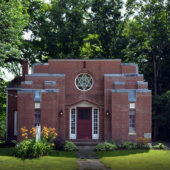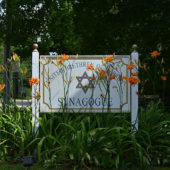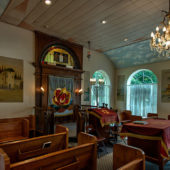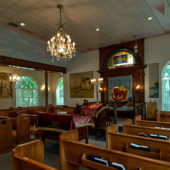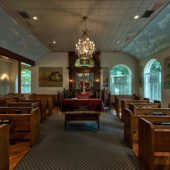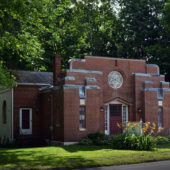People of many faiths donated their time and skills to the construction of this building.
Beginning in the 1880’s, a small Jewish community of 8-10 families had formed in the Hebron/Amston area. They had escaped poverty and persecution in Europe and moved to Eastern Connecticut to try their hand at farming. The Jews did not have the resources to build a temple. Through the early part of the twentieth century, the congregation met in members’ homes for Sabbath services.
In 1940, the decision was made to build a synagogue. A member of the congregation, Ira Turshen, designed the building. The cornerstone was laid in 1940. Many members of the community of all faiths donated their time and skills to the construction of the building. In September, 1941, the synagogue was completed. A dedication ceremony took place, in which clergy from the many houses of worship in Hebron participated. The torah, the handwritten scroll containing the five books of Moses, was transferred from the home of a congregant to the ark in the temple.
The exterior of the building has Art Deco design elements. As an Orthodox synagogue, the interior included a separate women’s section, located on one side of the sanctuary. The interior contains several murals of scenes of Israel painted directly on the walls. Downstairs there is a kitchen and an all-purpose room.
For many years, the building was used by a variety of community organizations. During World War II, Red Cross volunteers rolled bandages to be used by soldiers overseas. Other groups using the synagogue included the Girl Scouts, 4-H Club and even an elementary school wood-worki ng class. Hebrew school classes also met at the temple, as young Jewish children learned about their religion and customs in classes that met after school and on Sundays.
As the years went by, the congregation began to shrink in numbers and the building was used less frequently. Regular Saturday services were no longer held. Then, in the early 1990’s, the synagogue went through a significant growth period as Jewish families moved into Hebron, Columbia, Marlborough, and other nearby towns.
The congregation now consists of approximately 27 families and holds services once or twice a month. United Brethren is not affiliated with the Orthodox, Conservative or Reform movements, but has chosen to remain independent. No longer do women sit in a separate section. In fact, several of the key officers of the congregation are women, as is our spiritual leader, Cantor Diane Maran. The building has undergone improvements in the last few years, including getting a new roof, new well and new flooring. Recent additions to the sanctuary include a tree of life wall hanging and a new curtain for the ark, both designed and made by Sherry Bernstein, a member of the congregation. The synagogue, once again an important resource for the area’s Jewish community, remains a unique, historic building in the center of Hebron.

